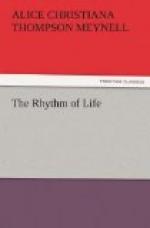Is there no egotism, ministering to his dignity, that man, having the law of the organism of the world written in his members, can take with him, out of the room that has been built to accord with him, into the landscape that stands only a little further away? He has deliberately made the smoking chair and the table; there is nothing to surprise him in their ministrations. But what profounder homage is rendered by the multitudinous Nature going about the interests and the business of which he knows so little, and yet throughout confessing him! His eyes have seen her and his ears have heard, but it would never have entered into his heart to conceive her. His is not the fancy that could have achieved these woods, this little flush of summer from the innumerable flowering of grasses, the cyclic recreation of seasons. And yet he knows that he is imposed upon all he sees. His stature gives laws. His labour only is needful—not a greater strength. And the sun and the showers are made sufficient for him. His furniture must surely be adjudged to pay him but a coarse flattery in comparison with the subjection, yet the aloofness, of all this wild world. This is no flattery. The grass is lumpy, as Mr. Oscar Wilde remarks with truth: Nature is not man’s lacquey, and has no preoccupation about his more commonplace comforts. These he gives himself indoors; and who prizes, with any self-respect, the things carefully provided by self-love? But when that farouche Nature, who has never spoken to him, and to whom he has never had the opportunity of hinting his wishes or his tastes—when she reveals the suggestions of his form and the desire of his eyes, and amongst her numberless purposes lets him surprise in her the purpose to accord with him, and lets him suspect further harmonies which he has not yet learnt to understand—then man becomes conscious of having received a token from her lowliness, and a favour from her loveliness, compared with which the care wherewith his tailor himself has fitted him might leave his gratitude cool.




